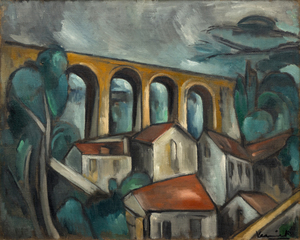MAURICE DE VLAMINCK (1876-1958)
 Maurice de Vlaminck was born in Paris in 1876 and began painting as a teenager. In 1900 while serving in the French army, Vlaminck met the aspiring artist Andre Derain on a train and the two became life-long friends. In the early 1900’s Vlaminck earned a living giving violin lessons and performing with bands in the evenings, allowing him to paint during the day. It was during this time that he worked and exhibited alongside Rouault, Matisse, and other artists that would come to define the Fauve movement. The artist traveled to London to paint by the Thames in 1911 before returning to France to again paint with Derain. Although he eventually settled in the suburbs of Paris and painted along the Seine, Vlaminck traveled throughout France later in his career. Vlaminck achieved great artistic success in his lifetime, exhibiting at museums such as the Salon des Independants and the Museum of Modern Art in New York, and his work continues to be significant today.
Maurice de Vlaminck was born in Paris in 1876 and began painting as a teenager. In 1900 while serving in the French army, Vlaminck met the aspiring artist Andre Derain on a train and the two became life-long friends. In the early 1900’s Vlaminck earned a living giving violin lessons and performing with bands in the evenings, allowing him to paint during the day. It was during this time that he worked and exhibited alongside Rouault, Matisse, and other artists that would come to define the Fauve movement. The artist traveled to London to paint by the Thames in 1911 before returning to France to again paint with Derain. Although he eventually settled in the suburbs of Paris and painted along the Seine, Vlaminck traveled throughout France later in his career. Vlaminck achieved great artistic success in his lifetime, exhibiting at museums such as the Salon des Independants and the Museum of Modern Art in New York, and his work continues to be significant today.
Building on the representational values of 19th century Impressionism, Fauvism emphasized strong color and painterly qualities. For Vlaminck, Van Gogh’s post impressionism was particularly influential. Upon seeing Van Gogh’s work for the first time at a 1901 exhibition, Vlaminck famously declared that he “loved Van Gogh more than his own father.” Soon after, her began painting by squeezing his pigments directly onto the canvas. Many of his works are similarly reminiscent of Toulouse-Lautrec’s bourgeois depictions of prostitutes and solitary drinkers. However in contrast, Vlaminck’s portraits maintain impersonality as a result of his deliberate neglect of physical details. Later in his career, he was influenced by Cezanne’s often-limited color palette. Although influenced by previous artistic movements, Vlaminck’s style consistently embodied the definitive qualities of Fauvism.

